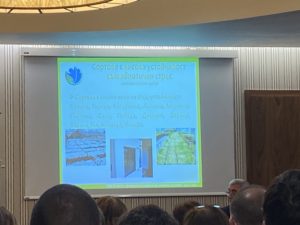
Assoc. Prof. Galina Mihova, a breeder of barley and wheat at Dobrudzha Agricultural Institute – General Toshevo, is a part of the team of work package 1.1. “Agricultural systems, adapted to climate changes” of Component 1. “Climate changes, eco system services and nutrition systems” of the National Research Program of the Ministry of Education of Bulgaria “Healthy foods for strong bio economy and quality of life”. The team, which acquired the results from the researches on the above topic, is a multi-disciplinary one. They have found out that the mean air temperature on Earth is with 1.4o higher, the frequency of extreme climate phenomena and biotic stress is also higher, the percent of contaminated soil is increasing, which could be a huge problem in a long-term perspective.
In her presentation “Back to Bulgarian breeding for a more sustainable production of wheat of higher quality under risky environment”, Assoc. Prof. Mihova presented the results from a 4-year testing of wheat during 2018 – 2022.
“Many achievements of the Bulgarian wheat breeding are betted accepted abroad than in Bulgaria”, were the opening words of her presentation, the highlight of which was that there is no perfect variety, but a perfect varietal structure.
 The vegetative growth of wheat takes 9 months, and the biological peculiarities of the crop are subject to several factors: temperature, light, moisture, and any disturbance poses serious risks to this crop.
The vegetative growth of wheat takes 9 months, and the biological peculiarities of the crop are subject to several factors: temperature, light, moisture, and any disturbance poses serious risks to this crop.
Within the National Wheat Program, the research team set up a working collection, which includes a large number of varieties from different agro-ecological regions in Europe.
The aim is to observe the response of the varieties under different stress conditions. The Bulgarian breeding demonstrated low number of productive tillers, but the spike is with high seed set, high number of grains in spike and 1000 kernel weight. In French breeding, the main structure-formative component is the number of productive tillers, where there is high variation, but the varieties are simultaneously characterized by a low number of grains in spike and low weight. Similar are the tendencies in the wheat from Croatia and Germany.
The risk factors in wheat are the long droughts in the summer months, the low quality pre-sowing soil tillage, the high mean daily temperatures in the winter months, the considerable temperature amplitudes after resumed vegetative growth and the late spring frosts. Other risk factors are deteriorated phytosanitary conditions, weed associations, widespread pest infestations, diseases with high threshold of economic harmfulness, yellow rust and biotic stress.
These circumstances require introduction of innovative production technologies and breeding activities aimed at higher productivity by all possible means. “Even a small step can sometimes be the beginning of a long path leading to success”, said Assoc. Prof. Mihova. “The aim is to achieve sustainable production and high added value. The first step is the varietal structure. Varieties should be chosen, which are complementary to one another, and the use of certified seeds is obligatory, because they could not be replaced by other cultivars, which guarantee their genetic potential”.
The yield from wheat under the conditions of North Bulgaria is determined by the sum of active temperatures from heading to the end of the vegetative growth, i.e. during the period when the productive potential of wheat is being realized, the temperatures should be within the suitable range. In South Bulgaria, however, the yield correlates with the sum of active temperatures up to the period of heading, i.e. when the number of productive tillers is formed.
The results from the wheat tested at General Toshevo revealed high mean productivity in cultivars Dragana, Kalina, Kiara, Korona and Kosara. In cultivars Lazarka, Merilin and Pchelina a productivity of over 8 t/ha was achieved. These are wheats of group A – quality wheats. The results from the experiments in South Bulgaria were also good; in Sadovo very good differentiation of the cultivars was observed, i.e. the breeding there differed from that in North Bulgaria.
The factors genotype and genotype x location were with the highest effect on the differentiation of the cultivars. “You cannot judge the potential of a cultivar, which was tested at one location only. It should be tested under variable conditions to determine its specific response under different climates. The cultivars with high stability are Niki, Pchelina, Laska, Tina, Mustang and Yara. Of the two cultivars included in system of the Executive Agency of variety testing, field inspection and seed control there is a Bulgarian one, Enola, and a French one, Avenue, Enola giving better performance according to coefficients”, commented Assoc. Prof. Mihova.
The specificity of the regional breeding consists in more rapidly resumed vegetative growth in the spring months, earlier date to heading, anthesis, pollination and fertilization. The Bulgarian breeding is also characterized by higher stem, but under stress, the short-stemmed varieties do not perform so well and cannot feed a spike with a good seed set.
“Our cultivars are efficient, not pretentious, they do not need luxury conditions, but the farmer should observe timely agronomy practices, although with moderate input. The realization of the productivity potential completely compensates for and adds value to all the investments”, concluded Assoc. Prof. Mihova.
The aim of our team is to search for a balanced combination between the yield components and the other components of wheat. A new focus is also the development of winter wheat genotypes suitable for organic production.


